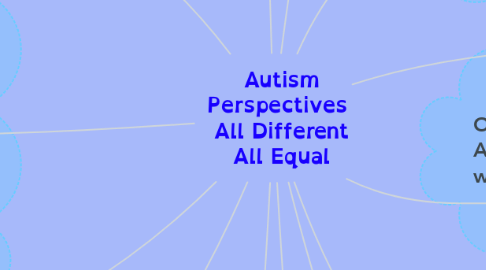
1. Sensory
1.1. Feels words - slimy, prickly
1.2. Doesn't like crowds
1.3. Doesn't like to be touched
1.4. Hypersensory/Hyposensory to clothing
1.5. Overstimulated if too much input
1.5.1. Sounds can be distracting - too loud
1.5.2. Visual input can cause sensory - emotional response - too much at once
1.5.3. Smells can heighten emotional responses
1.6. Flipside - under stimulated if not enough input
2. Behaviour
2.1. Often a reaction to over/under stimulus
2.2. Making sense of the world around them
2.3. Easily distracted
2.4. If changes are noted it is often due to something else changing that is difficult to cope with
3. Social/Communication
3.1. Struggle to interact with peers as have different levels of understanding
3.2. May mature later than their peers causing frustration
3.3. Struggle relating/understanding others
3.4. Often do want to make friends but lack of socialisation during younger years can lead to lack of social skills and inability to know where to start
3.5. Social cues such as facial expression and vocal tone often misconstrued/misread
3.5.1. Differs each day if someone says hello one day then not the next self doubt sets into the mindset as to if they have done something to cause this
3.5.1.1. Can then lead to anxiety and stress
3.6. Desperate to fit in so easily persuaded to misbehave by others
3.7. Often unable to make or maintain eye contact leading to anxiety
4. Sensitive
4.1. Often overthinks how others may feel
4.2. Doesn't like others to be left out
4.3. Easily annoyed
4.4. Anxiety can be unbearable leading to heightened emotions and a need for social isolisation
5. Rules often important
5.1. Can cause anxiety if rules are unknown
5.2. If others don't follow rules can cause heightened emotional response
5.3. Flipside - Rules are not important and not to be followed
6. Associated Barriers
6.1. Oppositional Defiance Disorder
6.2. Pathological Demand Avoidance
6.3. Speech and language difficulties
6.3.1. Aphasia
6.4. Dyspraxia
6.5. Sleep deprivation
6.5.1. Rituals at nigh-time often to combat anxiety
6.6. Attention span difficulties
6.7. Hyperlexia
7. Others lack understanding
7.1. Lack of knowledge could lead to further anxiety - meltdown due to needs not being met
7.2. Lack of support
8. Often fantastic recall of facts
8.1. Usually on subjects that are of interest
8.2. Flipside - struggle to recall information that is of no interest
9. Coping mechanisms strategies to combat emotional/physical responses
9.1. Counting on fingers
9.2. Rituals to comfort and self - regulate
9.2.1. Repetition of phrases to calm
9.3. School refusal to try and minimize own stress
9.4. Bad feelings about themselves often over compensated by being excessively apologetic to others
9.5. safe and familiar territory
9.6. Fiddle toys
9.7. Medication
9.8. Stimming
9.9. Hand flapping/biting
10. Once you've met a person with Autism - you've met a person with autism
10.1. No two people are the same
10.1.1. Value individuality
10.2. Girls often (not always) present differently to boys
10.2.1. Masking
11. Structure/Routine
11.1. Rituals/repetition to enable a sense of control
11.2. Can display OCD like symptoms with a need/desire to have things symmetrical/lined up
12. School Support
12.1. Low funding can lead to lack of understanding
12.2. Lack of training / enthusiasm to train
12.3. Often associated conditions leading to multiple diagnosis
12.4. Struggle to complete tasks in school
12.5. Can often be expelled due to behaviour if undiagnosed
12.6. Strategies to support
12.6.1. timers
12.6.2. timetables
12.6.3. colour coding
12.6.4. Buzzwords codes to ask for help
12.7. Time to assimilate an environment
12.7.1. Brain power all taken up by this so no work can be completed
12.8. Successful placements need preparation
13. Lifelong diagnosis
13.1. Usually less visible as the child grows and is able to self regulate more
13.2. often easier to make friends when older as people are more understanding
13.3. 12-15% of adults stay in sustainable employment
13.4. Differing levels of autism
13.4.1. High functioning - Aspergers (no longer diagnosed separately)
13.4.1.1. Can be a hidden disability/barrier
13.4.2. ADHD - often behavioural/sensory
13.4.3. Wide spectrum of needs
13.4.3.1. Varying levels
13.4.3.1.1. Constant care/inability to realise safety needs - i.e road safety
13.4.3.1.2. Invisible need - often anxiety with less visible
